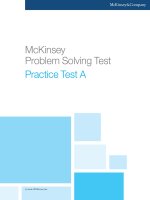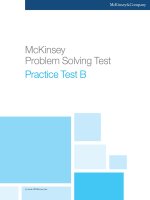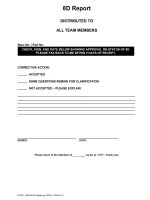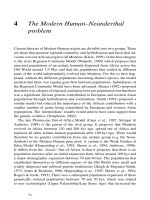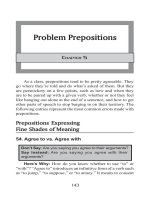Problem Solving
Bạn đang xem bản rút gọn của tài liệu. Xem và tải ngay bản đầy đủ của tài liệu tại đây (201.68 KB, 24 trang )
Translating Words into Numbers
To solve word problems, you must be able to translate words into mathematical operations. You must analyze the
language of the question and determine what the question is asking you to do.
The following list presents phrases commonly found in word problems along with their mathematical
equivalents:
■
A number means a variable.
Example
17 minus a number equals 4.
17 Ϫ x ϭ 4
■
Increase means add.
Example
a number increased by 8
x ϩ 8
CHAPTER
Problem Solving
This chapter reviews key problem-solving skills and concepts that you
need to know for the SAT. Throughout the chapter are sample ques-
tions in the style of SAT questions. Each sample SAT question is fol-
lowed by an explanation of the correct answer.
8
149
■
More than means add.
Example
4 more than a number
4 ϩ x
■
Less than means subtract.
Example
8 less than a number
x Ϫ 8
■
Times means multiply.
Example
6 times a number
6x
■
Times the sum means to multiply a number by a quantity.
Example
7 times the sum of a number and 2
7(x ϩ 2)
■
Note that variables can be used together.
Example
A number y exceeds 3 times a number x by 12.
y ϭ 3x ϩ 12
■
Greater than means > and less than means <.
Examples
The product of x and 9 is greater than 15.
x ϫ 9 > 15
When 1 is added to a number x, the sum is less than 29.
x ϩ 1 < 29
■
At least means ≥ and at most means ≤.
Examples
The sum of a number x and 5 is at least 11.
x ϩ 5 ≥ 11
When 14 is subtracted from a number x, the difference is at most 6.
x Ϫ 14 ≤ 6
■
To square means to use an exponent of 2.
–
PROBLEM SOLVING
–
150
Example
The square of the sum of m and n is 25.
(m ϩ n)
2
ϭ 25
Practice Question
If squaring the sum of y and 23 gives a result that is 4 less than 5 times y, which of the following equations
could you use to find the possible values of y?
a. (y ϩ 23)
2
ϭ 5y Ϫ 4
b. y
2
ϩ 23 ϭ 5y Ϫ 4
c. y
2
ϩ (23)
2
ϭ y(4 Ϫ 5)
d. y
2
ϩ (23)
2
ϭ 5y Ϫ 4
e. (y ϩ 23)
2
ϭ y(4 Ϫ 5)
Answer
a. Break the problem into pieces while translating into mathematics:
squaring translates to raise something to a power of 2
the sum of y and 23 translates to (y ϩ 23)
So, squaring the sum of y and 23 translates to (y ϩ 23)
2
.
gives a result translates to ϭ
4 less than translates to something Ϫ 4
5 times y translates to 5y
So, 4 less than 5 times y means 5y Ϫ 4.
Therefore, squaring the sum of y and 23 gives a result that is 4 less than 5 times y translates to: (y ϩ 23)
2
ϭ 5y Ϫ 4.
Assigning Variables in Word Problems
Some word problems require you to create and assign one or more variables. To answer these word problems, first
identify the unknown numbers and the known numbers. Keep in mind that sometimes the “known” numbers won’t
be actual numbers, but will instead be expressions involving an unknown.
Examples
Renee is five years older than Ana.
Unknown ϭ Ana’s age ϭ x
Known ϭ Renee’s age is five years more than Ana’s age ϭ x ϩ 5
Paco made three times as many pancakes as Vince.
Unknown ϭ number of pancakes Vince made ϭ x
Known ϭ number of pancakes Paco made ϭ three times as many pancakes as Vince made ϭ 3x
Ahmed has four more than six times the number of CDs that Frances has.
Unknown ϭ the number of CDs Frances has ϭ x
Known ϭ the number of CDs Ahmed has ϭ four more than six times the number of CDs that Frances has ϭ
6x ϩ 4
–
PROBLEM SOLVING
–
151
Practice Question
On Sunday, Vin’s Fruit Stand had a certain amount of apples to sell during the week. On each subsequent
day, Vin’s Fruit Stand had one-fifth the amount of apples than on the previous day. On Wednesday, 3 days
later, Vin’s Fruit Stand had 10 apples left. How many apples did Vin’s Fruit Stand have on Sunday?
a. 10
b. 50
c. 250
d. 1,250
e. 6,250
Answer
d. To solve, make a list of the knowns and unknowns:
Unknown:
Number of apples on Sunday ϭ x
Knowns:
Number of apples on Monday ϭ one-fifth the number of apples on Sunday ϭ
ᎏ
1
5
ᎏ
x
Number of apples on Tuesday ϭ one-fifth the number of apples on Monday ϭ
ᎏ
1
5
ᎏ
(
ᎏ
1
5
ᎏ
x)
Number of apples on Wednesday ϭ one-fifth the number of apples on Tuesday ϭ
ᎏ
1
5
ᎏ
[
ᎏ
1
5
ᎏ
(
ᎏ
1
5
ᎏ
x)]
Because you know that Vin’s Fruit Stand had 10 apples on Wednesday, you can set the expression for
the number of apples on Wednesday equal to 10 and solve for x:
ᎏ
1
5
ᎏ
[
ᎏ
1
5
ᎏ
(
ᎏ
1
5
ᎏ
x)] ϭ 10
ᎏ
1
5
ᎏ
[
ᎏ
2
1
5
ᎏ
x] ϭ 10
ᎏ
1
1
25
ᎏ
x ϭ 10
125 ϫ
ᎏ
1
1
25
ᎏ
x ϭ 125 ϫ 10
x ϭ 1,250
Because x ϭ the number of apples on Sunday, you know that Vin’s Fruit Stand had 1,250 apples on
Sunday.
Percentage Problems
There are three types of percentage questions you might see on the SAT:
1. finding the percentage of a given number
Example: What number is 60% of 24?
2. finding a number when a percentage is given
Example: 30% of what number is 15?
3. finding what percentage one number is of another number
Example: What percentage of 45 is 5?
–
PROBLEM SOLVING
–
152
To answer percent questions, write them as fraction problems. To do this, you must translate the questions
into math. Percent questions typically contain the following elements:
■
The percent is a number divided by 100.
75% ϭ
ᎏ
1
7
0
5
0
ᎏ
ϭ 0.75 4% ϭ
ᎏ
1
4
00
ᎏ
ϭ 0.04 0.3% ϭ
ᎏ
1
0
0
.3
0
ᎏ
ϭ 0.003
■
The word of means to multiply.
English: 10% of 30 equals 3.
Math:
ᎏ
1
1
0
0
0
ᎏ
ϫ 30 ϭ 3
■
The word what refers to a variable.
English: 20% of what equals 8?
Math:
ᎏ
1
2
0
0
0
ᎏ
ϫ a ϭ 8
■
The words is, are, and were, mean equals.
English: 0.5% of 18 is 0.09.
Math:
ᎏ
0
1
.
0
0
0
5
ᎏ
ϫ 18 ϭ 0.09
When answering a percentage problem, rewrite the problem as math using the translations above and then
solve.
■
finding the percentage of a given number
Example
What number is 80% of 40?
First translate the problem into math:
Now solve:
x ϭ
ᎏ
1
8
0
0
0
ᎏ
ϫ 40
x ϭ
ᎏ
3
1
,2
0
0
0
0
ᎏ
x ϭ 32
Answer: 32 is 80% of 40
■
finding a number that is a percentage of another number
Example
25% of what number is 16?
First translate the problem into math:
What number is 80% of 40?
x ϭ
40
ϫ
80
100
–
PROBLEM SOLVING
–
153
Now solve:
ᎏ
0
1
.
0
2
0
5
ᎏ
ϫ x ϭ 16
ᎏ
0
1
.2
0
5
0
x
ᎏ
ϭ 16
ᎏ
0
1
.2
0
5
0
x
ᎏ
ϫ 100 ϭ 16 ϫ 100
0.25x ϭ 1,600
ᎏ
0.
x
25
ᎏ
ϭ
ᎏ
1
0
,6
.2
0
5
0
ᎏ
x ϭ 6,400
Answer: 0.25% of 6,400 is 16.
■
finding what percentage one number is of another number
Example
What percentage of 90 is 18?
First translate the problem into math:
Now solve:
ᎏ
10
x
0
ᎏ
ϫ 90 ϭ 18
ᎏ
1
9
0
0
0
x
ᎏ
ϭ 18
ᎏ
1
9
0
x
ᎏ
ϭ 18
ᎏ
1
9
0
x
ᎏ
ϫ 10 ϭ 18 ϫ 10
9x ϭ 180
x ϭ 20
Answer: 18 is 20% of 90.
What precentage of 90 is 18?
x
100
ϭ
18
ϫ
90
0.25% of what number is 16?
x ϭ
16
ϫ
0.25
100
–
PROBLEM SOLVING
–
154
Practice Question
If z is 2% of 85, what is 2% of z?
a. 0.034
b. 0.34
c. 1.7
d. 3.4
e. 17
Answer
a. To solve, break the problem into pieces. The first part says that z is 2% of 85. Let’s translate:
Now let’s solve for z:
z ϭ
ᎏ
1
2
00
ᎏ
ϫ 85
z ϭ
ᎏ
5
1
0
ᎏ
ϫ 85
z ϭ
ᎏ
8
5
5
0
ᎏ
z ϭ
ᎏ
1
1
7
0
ᎏ
Now we know that z ϭ
ᎏ
1
1
7
0
ᎏ
. The second part asks: What is 2% of z? Let’s translate:
Now let’s solve for x when z ϭ
ᎏ
1
1
7
0
ᎏ
.
x ϭ
ᎏ
1
2
00
ᎏ
ϫ z Plug in the value of z.
x ϭ
ᎏ
1
2
00
ᎏ
ϫ
ᎏ
1
1
7
0
ᎏ
x ϭ
ᎏ
1,
3
0
4
00
ᎏ
ϭ 0.034
Therefore, 0.034 is 2% of z.
What is 2% of z?
zϭ
ϫ
2
100
x
z is 2% of 85
z ϭ
85
ϫ
2
100
–
PROBLEM SOLVING
–
155
Ratios
A ratio is a comparison of two quantities measured in the same units. Ratios are represented with a colon or as
a fraction:
x:y
ᎏ
x
y
ᎏ
3:2
ᎏ
3
2
ᎏ
a:9
ᎏ
9
a
ᎏ
Examples
If a store sells apples and oranges at a ratio of 2:5, it means that for every two apples the store sells, it sells 5
oranges.
If the ratio of boys to girls in a school is 13:15, it means that for every 13 boys, there are 15 girls.
Ratio problems may ask you to determine the number of items in a group based on a ratio. You can use the
concept of multiples to solve these problems.
Example
A box contains 90 buttons, some blue and some white. The ratio of the number of blue to white buttons is 12:6.
How many of each color button is in the box?
We know there is a ratio of 12 blue buttons to every 6 white buttons. This means that for every batch of
12 buttons in the box there is also a batch of 6 buttons. We also know there is a total of 90 buttons. This means
that we must determine how many batches of blue and white buttons add up to a total of 90. So let’s write an
equation:
12x ϩ 6x ϭ 90, where x is the number of batches of buttons
18x ϭ 90
x ϭ 5
So we know that there are 5 batches of buttons.
Therefore, there are (5 ϫ 12) ϭ 60 blue buttons and (5 ϫ 6) ϭ 30 white buttons.
A proportion is an equality of two ratios.
ᎏ
6
x
ᎏ
ϭ
ᎏ
4
7
ᎏ
ᎏ
3
1
5
ᎏ
ϭ
ᎏ
2
a
ᎏ
You can use proportions to solve ratio problems that ask you to determine how much of something is needed
based on how much you have of something else.
Example
A recipe calls for peanuts and raisins in a ratio of 3:4, respectively. If Carlos wants to make the recipe with 9
cups of peanuts, how many cups of raisins should he use?
Let’s set up a proportion to determine how many cups of raisins Carlos needs.
–
PROBLEM SOLVING
–
156
ᎏ
3
4
ᎏ
ϭ
ᎏ
9
r
ᎏ
This proportion means that 3 parts peanuts to 4 parts raisins must equal 9 parts peanuts to r parts raisins. We
can solve for r by finding cross products:
ᎏ
3
4
ᎏ
ϭ
ᎏ
9
r
ᎏ
3r ϭ 4 ϫ 9
3r ϭ 36
ᎏ
3
3
r
ᎏ
ϭ
ᎏ
3
3
6
ᎏ
r ϭ 12
Therefore, if Carlos uses 9 cups of peanuts, he needs to use 12 cups of raisins.
Practice Question
A painter mixes red, green, and yellow paint in the ratio of 6:4:2 to produce a new color. In order to make 6
gallons of this new color, how many gallons of red paint must the painter use?
a. 1
b. 2
c. 3
d. 4
e. 6
Answer
c. In the ratio 6:4:2, we know there are 6 parts red paint, 4 parts green paint, and 2 parts yellow paint.
Now we must first determine how many total parts there are in the ratio:
6 parts red ϩ 4 parts green ϩ 2 parts yellow ϭ 12 total parts
This means that for every 12 parts of paint, 6 parts are red, 4 parts are green, and 2 parts are yellow. We
can now set up a new ratio for red paint:
6 parts red paint:12 total parts ϭ 6:12 ϭ
ᎏ
1
6
2
ᎏ
Because we need to find how many gallons of red paint are needed to make 6 total gallons of the new
color, we can set up an equation to determine how many parts of red paint are needed to make 6 total
parts:
ᎏ
r p
6
a
p
rt
a
s
r
r
t
e
s
d
to
p
t
a
a
i
l
nt
ᎏ
ϭ
ᎏ
6
1
p
2
ar
p
ts
ar
r
t
e
s
d
to
p
t
a
a
i
l
nt
ᎏ
ᎏ
6
r
ᎏ
ϭ
ᎏ
1
6
2
ᎏ
Now let’s solve for r:
ᎏ
6
r
ᎏ
ϭ
ᎏ
1
6
2
ᎏ
Find cross products.
12r ϭ 6 ϫ 6
ᎏ
1
1
2
2
r
ᎏ
ϭ
ᎏ
3
1
6
2
ᎏ
r ϭ 3
Therefore, we know that 3 parts red paint are needed to make 6 total parts of the new color. So 3 gal-
lons of red paint are needed to make 6 gallons of the new color.
–
PROBLEM SOLVING
–
157
